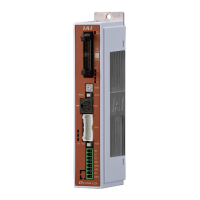POWER CON
PCON-CB/LC
9
7. Attempt not to exceed the actuator specifications in the pulse train control
mode.
In Pulse Train Control Mode, the operation is performed corresponding to the input pulse.
• Input Pulse Value → Moving distance
• Input pulse frequency → Velocity
• Change in Input Pulse Frequency → Velocity change and acceleration/deceleration
Do not use the actuator above the specifications (for stroke, maximum velocity, maximum
acceleration/deceleration) for the commands of the movement amount, velocity and
acceleration/deceleration from the host controller (PLC). Doing so may cause an error or
malfunction.
The pressing operation velocity should be set to the rated pressing velocity when it is to
conduct the pressing operation. Pressing with velocity not at the rated pressing velocity could
end up with pressing force different from that shown in “Push Force and Current-Limiting Value”
in Appendix in Chapter 10. Also, operation in velocity higher than the rated pressing velocity
could cause an error or malfunction.
Refer to “10.6 List of Specifications of Connectable Actuators” or model code for the
specifications and rated pressing velocity for each actuator.
8. Actuator would not operate without servo-on and pause signals.
(1) Servo ON Signal (SON)
Servo ON signal (SON) is selectable from “Enable” or “Disable” by using a parameter.
It is settable by parameter No.21 “selection of servo-on signal disable”.
[Refer to Chapter 8 Parameter.]
If it is set to “Enable”, the actuator would not operate unless turning this signal on.
If parameter No.21 is set to “1”, SON requirement is disabled.
If it is set to “Disable”, the servo becomes on and the actuator operation becomes enabled
as soon as the power supply to the controller is turned on and the emergency stop signal is
cancelled.
This parameter is set to “0” (Enable) at delivery. Have the setting that suits the desired
control logic.
(2) Pause Signal (*STP)
The input signal of the pause signal (*STP) is always on considering the safety. Therefore,
in general, the actuator would not operate if this signal is not on.
It is available to make this signal to “Disable”, if this signal is undesirable.
It is settable by parameter No.15 “Pause input disable”.
[Refer to Chapter 8 Parameter.]
If parameter No.15 is set to “1” (Disable), the actuator can operate even if this signal is not
on.
This parameter is set to “0” (Enable) at delivery.
9. Note that there are some frictions and/or torsions in through-hole of rotary
actuator when it is used.
When using rotary actuator with a through hole in the center of the revolution and using the
hole to put cables through, have a treatment to prevent wear from rubbing or wire break due to
the cables getting twisted.
Take particular note on actuators of 360-degree specification because they can be rotated
infinitely in a single direction.

